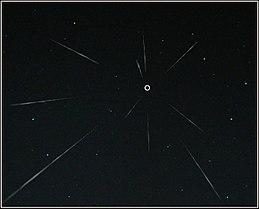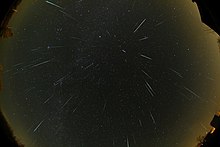
The radiant or apparent radiant of a meteor shower is the celestial point in the sky from which (from the point of view of a terrestrial observer) the paths of meteors appear to originate. The Perseids, for example, are meteors which appear to come from a point within the constellation of Perseus.
Meteor paths appear at random locations in the sky, but the apparent paths of two or more meteors from the same shower will diverge from the radiant. The radiant is the vanishing point of the meteor paths, which are parallel lines in three-dimensional space, as seen from the perspective of the observer, who views a two-dimensional projection against the sky. The geometric effect is identical to crepuscular rays, where parallel sunbeams appear to diverge.
A meteor that does not point back to the known radiant for a given shower is known as a sporadic and is not considered part of that shower.
Shower meteors may appear a short time before the radiant has risen in the observer's eastern sky. The radiant in such cases is above the horizon at the meteor's altitude.
During the active period of most showers, the radiant moves nearly one degree eastwards, parallel to the ecliptic, against the stellar background each day. This is called the radiant's diurnal drift, and is to a large degree due to the Earth's own orbital motion around the Sun, which also proceeds at nearly one degree a day. As the radiant is determined by the superposition of the motions of Earth and meteoroid, the changing orbital direction of the Earth towards the east causes the radiant to move to the east as well.
Cause

Meteor showers are mostly caused by the trails of dust and debris left in the wake of a comet. This dust continues to move along the comet's wake, and when the Earth moves through such debris, a meteor shower results. Because all of the debris is moving in roughly the same direction, the meteors which strike the atmosphere all "point" back to the direction of the comet's path.
As an exception, the Geminids are a shower caused by the object 3200 Phaethon, which is thought to be a Palladian asteroid.
Observation
The radiant is an important factor in observation. If the radiant point is at or below the horizon, then few if any meteors will be observed. This is because the atmosphere shields the Earth from most of the debris, and only those meteors which happen to be travelling exactly (or very near) tangential to the Earth's surface will be viewable.
References
- Earth Observatory Glossary: Radiant on NASA.gov
- Brian G. Marsden (1983-10-25). "IAUC 3881: 1983 TB AND THE GEMINID METEORS; 1983 SA; KR Aur". International Astronomical Union Circular. Retrieved 2011-07-05.
- "Exploding Clays Drive Geminids Sky Show?". 2010-10-12. Archived from the original on 2010-10-17.
| Meteor showers | |
|---|---|
| By name |
|
| By peak date | 
|
| Related topics |
|
| |